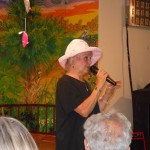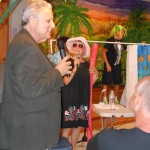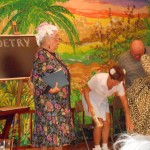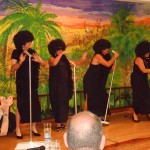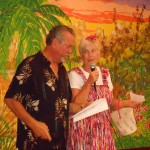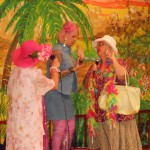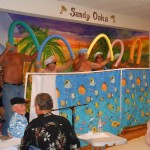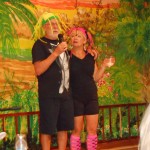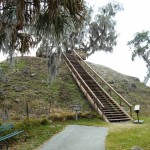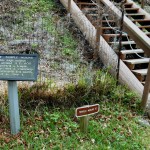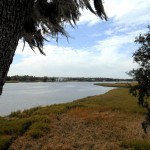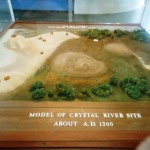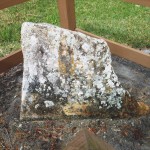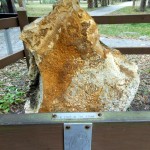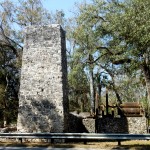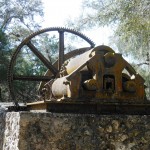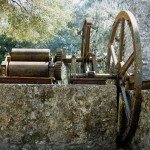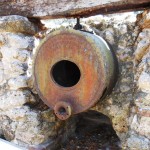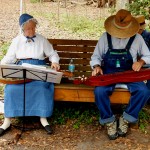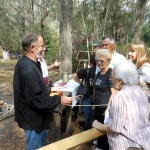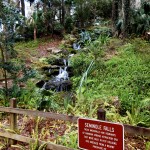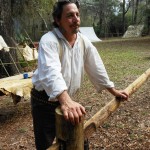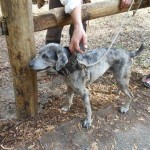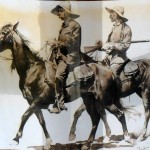While there’s entertainment at the campground clubhouse nearly every Saturday evening, there is one presentation that exceeds them all: the annual Sandy Oaks No Talent Show. It’s an evening of sidesplitting humor, as many of our fine citizens go all-out to give us a great evening. In fact, this is the only occasion where the hall becomes too small; if you don’t plunk down your five bucks early enough, you’re likely to be outside looking in. This year, two emcees kept us laughing between acts while “sets” were being changed onstage; in fact, Sharlene really put on her best Phyllis Diller. Pictures will tell the rest of the story.
Monthly Archives: February 2013
Another State Park – this one Pre-Columbian
The Crystal River Archeological State Park evidences the efforts of Native Americans who lived here in the 16th century. The area, however, was actually settled more than 2,500 years ago, a time when the river system had matured enough to support a sedentary population.
The 61 acre site consists of a half-dozen mounds and a vista of open ground looking out to the River. The largest mound, with a platform on its top, is a temple. The others are burial mounds. Also at the site is a midden, or dumping area for remnants of living – perhaps our equivalent of a garbage dump. An unexpected addition are two steles, or limestone slabs. One clearly depicts a face, while the other appears to be undecipherable. The site, an exceptionally calm place to walk and reflect, also included an artifact-laden visitors center. It’s a worthwhile stop.
- stairway to the top
- main mound
- view from the mound
- visitors center model
- stele #1 with face
- stele #2
The Yulee Sugar Mill
Another attraction in Homosassa is the Yulee Sugar Mill Ruins. David Yulee (1810-1886) was a Florida businessman and politician. He was born David Levy on St. Thomas, U.S. Virgin Islands, of Sephardic Jewish parents and later officially adopted Yulee, his father’s Sephardic surname. He served four years in the House of Representatives as a representative of the Florida Territory and when statehood was granted, he became the Senate’s first Jewish member in 1845. When Florida seceded, he joined the Congress of the Confederacy and, after the war, he was imprisoned in Fort Pulaski for 9 months for his “transgression.”
In 1853, he purchased a 5,000 acre sugar plantation along the River and operated it with slave labor. It was destroyed during the War, and the ruins are now a state historic site. David went on to build the Florida State Railroad, running from Cedar Key on the Gulf to Amelia Island on the Ocean. Also damaged by the War, he rebuilt it and subsequently became the president of four Florida lines, earning the appellation “Father of Florida Railroads. David and his family retired in 1880 to Washington, DC, his wife’s original area.
Nantucket Lightship Basketweaving at the Campground
Soon after I first arrived at Sandy Oaks, I offered to teach a 15 hour beginner’s class in Nantucket Lightship basketmaking. Initial reception was not the best, because most people share their skills without charge. I pointed out that all the funds over and above the cost of materials and supplies was sent to Schipperke Rescue. I taught five students in two sessions. A man from New Hampshire made two additional baskets while there, bought a mold and lots of supplies, and engaged his son, a furniture maker, to produce more molds for his use. And a number of people approached me before we left to sign up for the next season.
One of my J.C. Campbell students, 50 miles away in Gainesville, was aching to make a Reyes Friendship Basket, and she enlisted a friend to join her. The two worked partially at home and partially at the campground, staying down here long enough to get through the difficult parts.
This is really a win-win for me. I love passing this classic craft on to others, and I am happy to help enrich Schip rescue efforts with much needed cash.
Looking toward the future . . . we attended the Florida Tropical Weavers’ Guild conference in March at the invitation of my new dear friend, Myra Hudson. Myra, a skilled artisan in loom weaving and numerous other crafts, was the former student from Gainesville who made one of the purses this winter. Myra lured me there to introduce me to Pat Iverson, their director, hoping that Pat would consider me for a teaching gig at a future conference, and I’ve been contracted for March, 2015.
The Cracker Festival
Ranching isn’t the first occupation that comes to mind when one thinks of Florida. Back in the 18th century, however, it thrived at the hands of the Spanish colonists, native Seminoles and American settlers, who first drifted down from Georgia and mirrored the rough conditions. The cattle and horses introduced by the Spaniards were smaller and more stocky than later herds, but they offered the same challenges – and more so, since it was virtually free range. The Anglos became known as Crackers, presumably as a result of the noise from their whips. But the term became one of derision, representative of people who were crude, morally deficient brutes. No one was more responsible for this slight than cowboy artist number one, Frederick Remington, who, in the late 19th century, branded them as “wild-looking individuals” on what appeared to be “very emaciated Texas ponies.”
- Daddy’s little helper
- Musicians
- Candle Making
- Rainbow Springs
- Still a Cracker
- Catahoula Panther Cur
- Weaver
- Crackers in portrait
Undaunted, Crackers are very proud of their heritage. And among their events, Florida Crackers celebrate annually in February in Rainbow Springs State Park in Dunnellon, just north of Citrus County. It was there that we met not only genuine Crackers but also their sturdy horses, cattle and a mascot — a Catahoula Panther Cur. The dog is a member of the first breed created in North America, native to Catahoula County in Louisiana. Its principal talent is boar hunting, and the heavy collar is designed to protect the neck and throat from the swine’s vicious teeth. During the weekend, we also visited home makers, music makers and craft makers of every stripe.
The Florida Cracker Trail Association is dedicated to preserving the Cracker legacy through education, active involvement and scholarship. Each year, they hold a week-long Cross-Florida Cracker Trail Ride (without cattle) from the Sarasota area on the west coast to Fort Pierce on the east.

